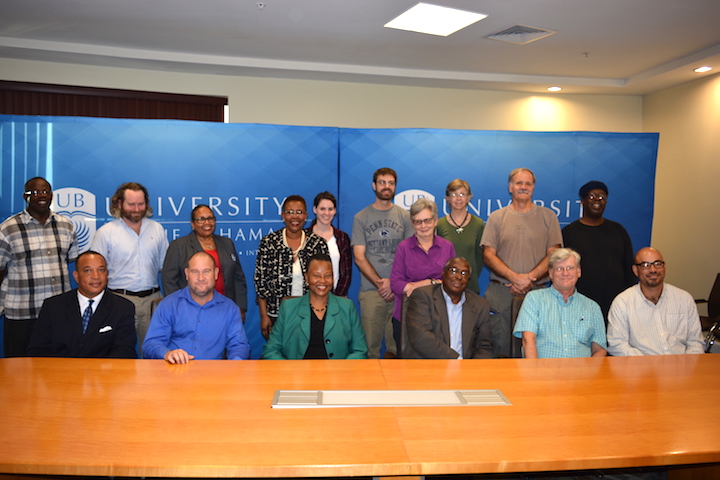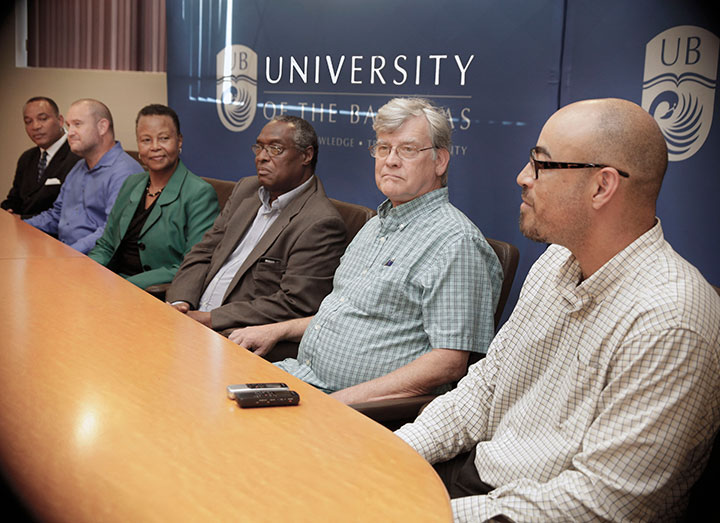|

|
 |
|
Last Updated: Feb 13, 2017 - 1:45:37 AM |

Administrators, historians, archeologists and graduate researchers from the University of The Bahamas, Antiquities, Monuments and Museums Corporation (AAMC) and Florida Museum of Natural History announced the discovery of ancient skeletal remains buried in the sand dunes near Clarence Town, Long Island.
|
(November 30th) A multi-sectoral team of researchers and scientists has begun the tedious work of excavating ancient remains buried in the sand dunes of Clarence Town, Long Island. The remains are believed to be those of Lucayans who inhabited the islands between 600 AD and the 1500s.
The recent groundbreaking discovery has national and international research, archaeological and historical significance as it relates to the history of the Commonwealth of The Bahamas.
A multi-sectoral team of researchers and scientists has begun the tedious work of excavating ancient remains buried in the sand dunes of Clarence Town, Long Island. The remains are believed to be those of Lucayans who inhabited the islands between 600 AD and the 1500s.
The recent groundbreaking discovery has national and international research, archaeological and historical significance as it relates to the history of the Commonwealth of The Bahamas.
The Antiquities, Monuments and Museums Corporation (AMMC) is working in conjunction with the Florida Museum of Natural History and University of The Bahamas (UB) to unearth the remains, search for potentially new burial sites, investigate how life may have been for these early inhabitants of The Bahamas and document the findings.
“What we are looking for at the end of the day is perhaps rewriting Pre-Columbian history of these islands,” shared the Director of AMMC Dr. Keith Tinker.
“What we are hearing now today is a paradigm shift in the interpretation of the history...we are speaking about our early history and I personally feel it is going to redefine how we interpret that history so that no longer, like in my case and others, we hear misinformation. Now we hear new information and it can be used to properly guide us,” he added.
Dr. Tinker was one of several persons who addressed a press conference held at UB’s Harry C. Moore Library and Information Centre on Tuesday, November 29th. The others included senior administrators of UB, officials of the AMMC and representatives of the Florida Museum of Natural History.
Assistant Director of the AMMC Dr. Michael Pateman explained that initial excavations uncovered three, possibly four, sets of burial sites in the sand dunes of Clarence Town Long Island. Further excavations were scheduled to recommence on Wednesday to continue investigating the extent of Lucayan sites in the area.
“This is a once in a lifetime site for archaeologists. We used to believe that the Lucayans buried their dead in blue holes. Now with the research coming out of this site we now know that they buried them on beach dunes. As Dr. Tinker said we hope to rewrite Bahamian history,” Dr. Pateman shared.
According to the AMMC, Long Island resident Nick Constantakis found the first set of ancient remains of what appears to be an elderly Lucayan male, buried face down in the sand dunes. Nick and Anthony Maillis of Clarence Town discovered a second burial approximately 25 feet away from where the original bones were located of purportedly an elderly Lucayan female buried face down. Subsequently, a third set of remains was found directly under the second burial site.

Nassau The Bahamas - The University of The Bahamas (UB) in collaboration with the Antiquities, Monuments and Museums Corporation (AMMC) and the Florida Museum of Natural History held a press conference at the university, November 29, 2016 to announce plans to search for Ancient Remains in Long Island. The collaboration was formalized with the recent signing of Memoranda of Understanding (MU) among the parties. College students in the United States and one UB student who is from Long Island, majoring in history, are participating in the search effort. Provost at UB Dr. Linda Davis (pictured) said this collaboration can be useful and may be the beginning of a student exchange programme. Director of AMMC Dr. Keith Tinker (pictured centre) said, "this could be interesting and the results could help to rewrite Bahamian history." Participating persons from the three entities are scheduled to leave for Long Island November 30 returning December 13. (BIS Photo/Derek Smith)
|
In establishing the context for the discovery and the potential implications, University of The Bahamas Provost Dr. Linda Davis expounded on the role of research on a national and international level. UB has established a partnership with the Florida Museum of Natural History.
“It is research that will define the institution. It is research from our faculty, multisectoral partnerships throughout our country, throughout our region, and of course globally that will enable us to do the kinds of things that we ought to be doing,” she said.
Chair of UB’s Social Sciences Dr. Christopher Curry added that this collaborative expedition can only augur well for UB students.
“This is a watershed moment for the University as we develop new programmes and enhance our ability to do research. We are looking forward to, in the near future, developing a Minor in Anthropology. In the short-term at least we have field study courses that hopefully will allow our students to gain valuable exposure,” he said.
Dr. William Keegan, the lead archaeologist from the Florida Museum of Natural History explained that the excavation has two main goals: determine if there are any other burial sites and find out how these Lucayans lived in The Bahamas.
“We are trying to get a better definition of what life was like in that area at that time. It's something that we need to continue to do throughout the islands,” said Dr. Keegan.
“This is significant because this is the first possible Lucayan cemetery that has ever been found in The Bahamas. I think the reason is that we just weren't looking in the right place.”
Volunteers on the excavation team are from the Antiquities Monuments and Museums Corporation in New Providence and Long Island, University of The Bahamas, Florida Museum of Natural History, Penn State University, and other institutions in Ohio and New York. Among the devices that will be used is a ground penetrating radar. (AMMC) is working in conjunction with the Florida Museum of Natural History and University of The Bahamas (UB) to unearth the remains, search for potentially new burial sites, investigate how life may have been for these early inhabitants of The Bahamas and document the findings.
“What we are looking for at the end of the day is perhaps rewriting Pre-Columbian history of these islands,” shared the Director of AMMC Dr. Keith Tinker.
“What we are hearing now today is a paradigm shift in the interpretation of the history...we are speaking about our early history and I personally feel it is going to redefine how we interpret that history so that no longer, like in my case and others, we hear misinformation. Now we hear new information and it can be used to properly guide us,” he added.
Dr. Tinker was one of several persons who addressed a press conference held at UB’s Harry C. Moore Library and Information Centre on Tuesday, November 29th. The others included senior administrators of UB, officials of the AMMC and representatives of the Florida Museum of Natural History.
Assistant Director of the AMMC Dr. Michael Pateman explained that initial excavations uncovered three, possibly four, sets of burial sites in the sand dunes of Clarence Town Long Island. Further excavations were scheduled to recommence on Wednesday to continue investigating the extent of Lucayan sites in the area.
“This is a once in a lifetime site for archaeologists. We used to believe that the Lucayans buried their dead in blue holes. Now with the research coming out of this site we now know that they buried them on beach dunes. As Dr. Tinker said we hope to rewrite Bahamian history,” Dr. Pateman shared.
According to the AMMC, Long Island resident Nick Constantakis found the first set of ancient remains of what appears to be an elderly Lucayan male, buried face down in the sand dunes. Nick and Anthony Maillis of Clarence Town discovered a second burial approximately 25 feet away from where the original bones were located of purportedly an elderly Lucayan female buried face down. Subsequently, a third set of remains was found directly under the second burial site.
In establishing the context for the discovery and the potential implications, University of The Bahamas Provost Dr. Linda Davis expounded on the role of research on a national and international level. UB has established a partnership with the Florida Museum of Natural History.
“It is research that will define the institution. It is research from our faculty, multisectoral partnerships throughout our country, throughout our region, and of course globally that will enable us to do the kinds of things that we ought to be doing,” she said.
Chair of UB’s Social Sciences Dr. Christopher Curry added that this collaborative expedition can only augur well for UB students.
“This is a watershed moment for the University as we develop new programmes and enhance our ability to do research. We are looking forward to, in the near future, developing a Minor in Anthropology. In the short-term at least we have field study courses that hopefully will allow our students to gain valuable exposure,” he said.
Dr. William Keegan, the lead archaeologist from the Florida Museum of Natural History explained that the excavation has two main goals: determine if there are any other burial sites and find out how these Lucayans lived in The Bahamas.
“We are trying to get a better definition of what life was like in that area at that time. It's something that we need to continue to do throughout the islands,” said Dr. Keegan.
“This is significant because this is the first possible Lucayan cemetery that has ever been found in The Bahamas. I think the reason is that we just weren't looking in the right place.”
Volunteers on the excavation team are from the Antiquities Monuments and Museums Corporation in New Providence and Long Island, University of The Bahamas, Florida Museum of Natural History, Penn State University, and other institutions in Ohio and New York. Among the devices that will be used is a ground penetrating radar.
More:
Ancient Lucayan Skeletons Discovered in Clarence Town, Long Island

© Copyright 2016 by thebahamasweekly.com
Top of Page
|
|
 |

|
